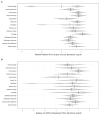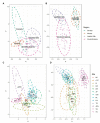Soil Microbiomes With the Genetic Capacity for Atmospheric Chemosynthesis Are Widespread Across the Poles and Are Associated With Moisture, Carbon, and Nitrogen Limitation
- PMID: 32903524
- PMCID: PMC7437527
- DOI: 10.3389/fmicb.2020.01936
Soil Microbiomes With the Genetic Capacity for Atmospheric Chemosynthesis Are Widespread Across the Poles and Are Associated With Moisture, Carbon, and Nitrogen Limitation
Abstract
Soil microbiomes within oligotrophic cold deserts are extraordinarily diverse. Increasingly, oligotrophic sites with low levels of phototrophic primary producers are reported, leading researchers to question their carbon and energy sources. A novel microbial carbon fixation process termed atmospheric chemosynthesis recently filled this gap as it was shown to be supporting primary production at two Eastern Antarctic deserts. Atmospheric chemosynthesis uses energy liberated from the oxidation of atmospheric hydrogen to drive the Calvin-Benson-Bassham (CBB) cycle through a new chemotrophic form of ribulose-1,5-bisphosphate carboxylase/oxygenase (RuBisCO), designated IE. Here, we propose that the genetic determinants of this process; RuBisCO type IE (rbcL1E) and high affinity group 1h-[NiFe]-hydrogenase (hhyL) are widespread across cold desert soils and that this process is linked to dry and nutrient-poor environments. We used quantitative PCR (qPCR) to quantify these genes in 122 soil microbiomes across the three poles; spanning the Tibetan Plateau, 10 Antarctic and three high Arctic sites. Both genes were ubiquitous, being present at variable abundances in all 122 soils examined (rbcL1E, 6.25 × 103-1.66 × 109 copies/g soil; hhyL, 6.84 × 103-5.07 × 108 copies/g soil). For the Antarctic and Arctic sites, random forest and correlation analysis against 26 measured soil physicochemical parameters revealed that rbcL1E and hhyL genes were associated with lower soil moisture, carbon and nitrogen content. While further studies are required to quantify the rates of trace gas carbon fixation and the organisms involved, we highlight the global potential of desert soil microbiomes to be supported by this new minimalistic mode of carbon fixation, particularly throughout dry oligotrophic environments, which encompass more than 35% of the Earth's surface.
Keywords: atmospheric chemosynthesis; carbon fixation; environmental drivers; photosynthesis; quantitative PCR; trace gases.
Copyright © 2020 Ray, Zhang, Terauds, Ji, Kong and Ferrari.
Figures





Similar articles
-
Atmospheric chemosynthesis is phylogenetically and geographically widespread and contributes significantly to carbon fixation throughout cold deserts.ISME J. 2022 Nov;16(11):2547-2560. doi: 10.1038/s41396-022-01298-5. Epub 2022 Aug 6. ISME J. 2022. PMID: 35933499 Free PMC article.
-
Clearing the air: unraveling past and guiding future research in atmospheric chemosynthesis.Microbiol Mol Biol Rev. 2023 Dec 20;87(4):e0004823. doi: 10.1128/mmbr.00048-23. Epub 2023 Nov 1. Microbiol Mol Biol Rev. 2023. PMID: 37914532 Free PMC article. Review.
-
Hydrogen-Oxidizing Bacteria Are Abundant in Desert Soils and Strongly Stimulated by Hydration.mSystems. 2020 Nov 17;5(6):e01131-20. doi: 10.1128/mSystems.01131-20. mSystems. 2020. PMID: 33203691 Free PMC article.
-
Atmospheric trace gases support primary production in Antarctic desert surface soil.Nature. 2017 Dec 21;552(7685):400-403. doi: 10.1038/nature25014. Epub 2017 Dec 6. Nature. 2017. PMID: 29211716
-
Microbial oxidation of atmospheric trace gases.Nat Rev Microbiol. 2022 Sep;20(9):513-528. doi: 10.1038/s41579-022-00724-x. Epub 2022 Apr 12. Nat Rev Microbiol. 2022. PMID: 35414013 Review.
Cited by
-
Out of Thin Air? Astrobiology and Atmospheric Chemotrophy.Astrobiology. 2022 Feb;22(2):225-232. doi: 10.1089/ast.2021.0066. Epub 2022 Jan 13. Astrobiology. 2022. PMID: 35025628 Free PMC article. Review.
-
Ecological significance of Candidatus ARS69 and Gemmatimonadota in the Arctic glacier foreland ecosystems.Appl Microbiol Biotechnol. 2024 Dec;108(1):128. doi: 10.1007/s00253-023-12991-6. Epub 2024 Jan 15. Appl Microbiol Biotechnol. 2024. PMID: 38229335 Free PMC article.
-
Multiple energy sources and metabolic strategies sustain microbial diversity in Antarctic desert soils.Proc Natl Acad Sci U S A. 2021 Nov 9;118(45):e2025322118. doi: 10.1073/pnas.2025322118. Proc Natl Acad Sci U S A. 2021. PMID: 34732568 Free PMC article.
-
Soil Microbiome Influences on Seedling Establishment and Growth of Prosopis chilensis and Prosopis tamarugo from Northern Chile.Plants (Basel). 2022 Oct 14;11(20):2717. doi: 10.3390/plants11202717. Plants (Basel). 2022. PMID: 36297741 Free PMC article.
-
Advocating microbial diversity conservation in Antarctica.NPJ Biodivers. 2025 Mar 4;4(1):5. doi: 10.1038/s44185-025-00076-8. NPJ Biodivers. 2025. PMID: 40038369 Free PMC article. Review.
References
-
- Archer E. (2013). Estimate permutation p-values for importance metrics. R package version 1.5.2.
-
- Bay S., Ferrari B., Greening C. (2018). Life without water: how do bacteria generate biomass in desert ecosystems? Microbiol. Aust. 39, 28–32. 10.1071/MA18008 - DOI
LinkOut - more resources
Full Text Sources
Miscellaneous

